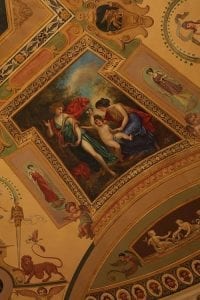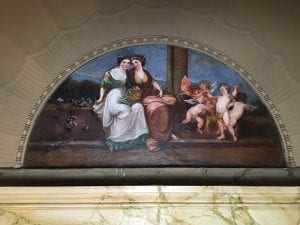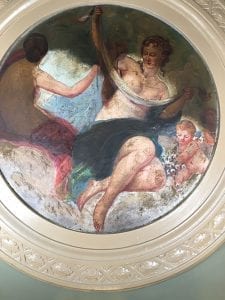A Peek Into the Steinway Hall Rotunda Restoration
– What it Once was and Would be Again –
The original landmarked building Steinway Hall is where the famed Steinway & Sons housed its iconic collection of pianos for many years. Designed in 1925 by Warren & Wetmore, the architects most notably associated with the design of Grand Central Terminal. With its location across from Carnegie Hall, Steinway & Sons saw the building as an opportunity for increasing sales. Steinway Hall is one of New York City’s most impressive Neo-Renaissance style interiors located on the north side of West 57th Street, between Sixth and Seventh Avenues at 111 West 57th Street. The Steinway Hall interior was designated a landmark in 2013 joining the exterior structure which was designated a landmark in 2001. The primary space on the first floor is a double-height octagonal domed rotunda reception room with grand opulent decoration. The rotunda stands about 35 feet tall and was designed to function as a circulation hub, receiving visitors, musicians, and potential customers. The decorative features include ceiling murals, painted medallions, pilasters, faux marble plaster arches, finials and other ornate elements. Many of the decorative features are inspired by the musical arts such as the exterior bas-relief elements in the tympanum, portraying Apollo and a musical muse.
Before and After Restoration of the Steinway Hall Rotunda
The building was purchased by JDS Development Group in 2013 and they have since converted the building into a residential development. The rotunda will continue to serve as retail space for New Yorkers and visitors to enjoy, and will not be part of the residential portion of the building. As a part of their renovations, John Canning & Co. was brought in by JDS Development in 2019 for the restoration of the architectural paint finishes in the historic rotunda, adjacent vestibules, and upper and lower elevator lobbies. The project included the fine art conservation of murals in the rotunda space.
(Before and After)
Over the years there has been many stewards of this building, some have been very aware of the historic decoration and did right things, while some differed in maintenance approaches or may not have known the right things to do (maybe a janitor or building maintenance person might have performed the work and not have been trained in the required craftsmanship). Marble pilasters and columns hold up the Steinway Hall structure. The entablatures were cast plaster and painted faux marble. Different materials were used in that period and nicely complimented the genius architectural style. This had to be taken in to account for the repairs and inpainting on the walls and rotunda. In order to be able to do this an historic finishes investigation was performed to document the paint chronology and historic color palette. Using this research, we worked with the designers and owners to pick colors based on the history.

Rotunda’s four prominent allegorical scenes in need of assessment before conservation began.
Before conservation began, an initial assessment of the rotunda mural artwork was performed. The artwork on the rotunda features four prominent allegorical scenes, set within elaborate painted frames. The scenes depict women dancing and playing with putti and playing different instruments, all theatrical and reflect the intended mood of the space. Paul Arndt, an 1881 artist that lived in NY and worked in different styles and mediums, is the main artist credited for these allegorical scenes.
A couple of the allegorical scenes (Before and After).
The figurative works like the putti were all done on canvas in a studio and then marouflage to the ceiling. Swags and wreathes were directly applied to the substrate. These were common practices of the period. This allowed them to build up the artwork and think through in the totality at floor level. Since the rotunda is a compounded curve dome shape, painters/journeymen had to geometrically lay things out in the field. This also allows the space to be under construction and plaster to cure before painting or applying canvas. Gypsum plaster can take approximately 30 days to cure because the alkaline needs to set before painting or it causes issues. Working on canvas in the studio also reduces cost since scaffolding is not needed while the artist work is being done. A combination of marouflaging canvas onto the walls and the fresco-secco technique of painting on dried plaster was used for the supporting decoration.
One of the allegorical scenes progression (Before Varnish Removal, After Varnish Removal and Final Version).
When it comes to conservation of murals, there is the challenge of discovering and piecing together a puzzle to put it back to the way it was. This requires an interruption of the original intent of the work itself along with the assessment and investigation of the pieces. The assessment showed that the murals were damaged over time. History showed that there were 3-5 attempts to repair over the life time of the pieces. Our investigations uncovered layers of dirt and varnishes as well as heavy overpainting on some areas, and some repair work was just terribly done. The four primary paintings as well as all of the allegorical female figures and cherubs are oil on canvas, are mounted to the ceiling. The rest of the mural is oil on plaster and this includes all of the medallions, lions, frames, allegories with Greek mythological themes and decorative elements. Typical conditions of each aspect included an accumulation of surface dirt and grime, abrasions, incompatible varnishes, craquelure, and delamination and/or lifting of paint.
One of the scenes progression from before to after.
One of the scenes progression from before to after.
On the West Vestibule/North Elevator water damaged remained, varnish almost destroyed most of the scene and we had to stop because of the condition. There is stability in what is displayed but not in the appearance which is worn/weathered. This was left to show the history. In conservation, it is standard practice to preserve evidence of conditions for historic documentation and to provide the opportunity for future study. Those areas left untouched provide the complete environmental history of the building’s interior. A similar preserved swatch has been left behind at the Grand Central Sky Mural, above the Vanderbilt entrance. These patches both allows visitors to see the before and after of the cleaning and for future conservation teams to reference. During the assessment of the rotunda murals, we discovered on one of the puttie’s feet, that the heel revealed an amazing difference and turned into a wonderful joyous surprise. It was a light bulb showing what it once was and would be again.

Varnish removal Test on Puttie’s Foot revealing an amazing difference.
We also determined that entablatures and arches which for decades have thought to have been marble are actually a faux marble finish. These decorative details and finishes even extended into the closets. One area of note was the alcove marble in elevator lobby closet, this has black marble with a round arch that is also faux marble. It was determined that anything above seven feet high was faux marble. The subtlety of some materials utilized is a striking testament to the design and decoration of the craftsmanship. It was obvious that the designers and craftsman followed some of the basic Owen Jones principles that decorative arts should be natural and unassuming. Proposition 1 of The Grammar of Ornament states– “The Decorative Arts arise from, and should properly be attendant upon, Architecture.” Jones’ Grammar of Ornament originally published in 1856 remains one of the most influential decorative ornament books. Jones created the Grammar of Ornament to speak to young designers and craftsmen and remind them to look to history for the foundations of good design which is seen in Steinway Hall.
One of the painting progression (before and after varnish removal and final).

Old Steinway Rotunda after restoration.
As of February 2020, the historic Steinway Hall’s grand rotunda’s classical architecture and Italianate decorations have been successfully restored for all to enjoy and better feel the intended mood of the space with the dazzlingly restored murals and decorative finishes.































